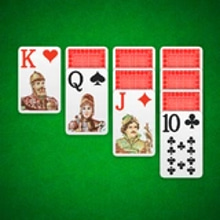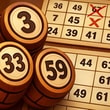The first flip is a promise. Red on black, black on red, a smooth cascade that feels inevitable when you see it and mysterious when you don’t. Double Klondike Solitaire takes that classic solitaire flow you know by heart and doubles the drama—two complete decks, eight foundations to climb, nine tableau columns to wrangle, and a steady back-and-forth rhythm between patience and boldness. It’s familiar, yes, but the extra cards turn small choices into satisfying chains, and the board becomes a playground for anyone who loves planning two, three, four moves ahead.
Two decks, bigger decisions 🃏🃏
With 104 cards in play, the tableau breathes differently. You still build down in alternating colors on the columns, and you still grow each foundation by suit from Ace upward—but the second copy of every rank means there’s always another option hiding one card deeper. Do you free a red 9 to unlock a long red-black ladder, or hold it so a different column can move an entire stack in one sweep? Double Klondike rewards that kind of roadmap thinking. Clear space early, keep lanes open for long transfers, and watch how a single empty column becomes a staging area that changes everything.
Deal-1 vs. deal-3, your tempo your call 🎯⏱️
Want a thoughtful, surgical game? Choose deal-1 and read the stock like a book you can turn one quiet page at a time. Want classic tension and bigger reveals? Deal-3 gives you rhythm and risk—card order matters, memory matters, and each pass through the stock asks whether you’re seeing the pattern or forcing it. Both modes are fair; they just speak different dialects of the same language. If you’re learning Double Klondike’s flow, start with deal-1. When you crave pressure, bump to deal-3 and feel the tempo lift.
Customize the table, settle into the flow 🎨🧘
Change backs, choose crisp faces, pick a felt that matches your mood. The interface is clean on purpose—cards pop, legal moves feel obvious, and drag-and-drop is snappy whether you play on desktop or phone. There’s generous undo for experimenting, plus smart hints that nudge rather than spoil. You stay in control: test an idea, rewind if it clutters your lanes, and keep the line you liked best.
Daily tasks and gentle competition 📅🏆
A fresh card of mini-objectives lands each day—win in deal-3, finish under a time cap, clear with minimal hints. They’re short, playful goals that keep your hands warming up even when you only have five minutes. Progress tracking remembers your streaks, stats show how your win rate climbs as your habits sharpen, and leaderboards give you a reason to replay a good seed until your time drops from tidy to “how did I do that.” Chase the top spot or just use the numbers as a quiet mirror of improvement.
Reads that win games: play like a pro 🧠✨
Open space is oxygen. The first empty column you create should rarely stay empty; use it to shuttle long descending runs and free hidden face-downs. Prioritize flips over foundation greed—an early Ace is tempting, but revealing two unknowns on a deep column often buys you more future moves than banking one pip of progress. Color balance matters: if your tableau skews red, hunt the next black King or Queen that lets you split and re-stack for healthier alternation. When the stock holds both copies of a rank you need, note where they sit; timing your passes around those positions is how deal-3 stops feeling random and starts feeling solvable.
Sequences, not single cards 🧱➡️
In Double Klondike, moving a lone 7 is fine—but moving a 7-6-5-4 in one elegant slide is transformative. Aim to build long ladders in columns that are easy to free and keep those ladders flexible by avoiding early locks (like stacking two same-color 8s that choke your options). When you expose a King, think about its future neighbors before you slap it into the first empty lane. A good King placement is like setting an anchor—the rest of the column builds itself.
Undo and hints as learning tools, not crutches 🔁🧩
The unlimited undo is there to explore lines you aren’t sure about. Try the aggressive foundation push; if it starves your tableau, roll back and take the flip-first path instead. Hints will point to a legal move, but the best habit is pausing for a slow scan: left-to-right for flips, right-to-left for long transfers, stock last. Use hints to confirm your read, not replace it, and you’ll feel your speed rise without your accuracy falling.
Pacing and patience, the quiet edge 🫖💡
Double decks mean more ways to over-commit. Resist the urge to dump every low card to foundations the moment it appears; leaving a 2 on the tableau can keep two entire ladders mobile. Likewise, do not burn your empty spaces on the first King you see—hold at least one lane for maneuvering until a better King arrives. These tiny acts of restraint pay huge dividends two turns later when a full column slides free and five face-downs flip in a row.
Micro-skills that look like magic 🎯🪄
Stagger your foundations evenly; climbing one suit too far can trap its partner suit in the tableau. When a column shows twin 9s of opposite colors, park them so each can accept a different 8—future you will thank present you. On deal-3, count the visible stock in threes; knowing a needed card is “two taps away after this pass” prevents wasteful cycles. If a King enters play and you have two empty lanes, seed each with opposite colors (red King and black King) to maximize future alternation. And when in doubt, flip a card—new information is the best move in solitaire.
Why this variant sticks long after the win ⭐🔁
Because your improvement is visible in the shape of your board. Yesterday you filled lanes too fast and ran out of room. Today you hold space, build routes, and turn a snarled midgame into a clean endgame where foundations rise in parallel like piano keys. The second deck doesn’t make wins “luckier”; it makes smart sequencing incredibly rewarding. Every clear feels earned, and every near-miss teaches a habit you’ll use in the next run.
Kiz10 ease, coffee-break or marathon 🌐⚡
Load in your browser, tap a daily task between meetings, or sink an hour into shaving seconds off a seed that fits your eyes. Smooth on touch or mouse, readable on small screens, generous with undo and quick with shuffles—Double Klondike Solitaire on Kiz10 is the version you keep open in a tab and return to whenever your brain wants focus without fuss.
 Cunning Thief:
Cunning Thief: 













































